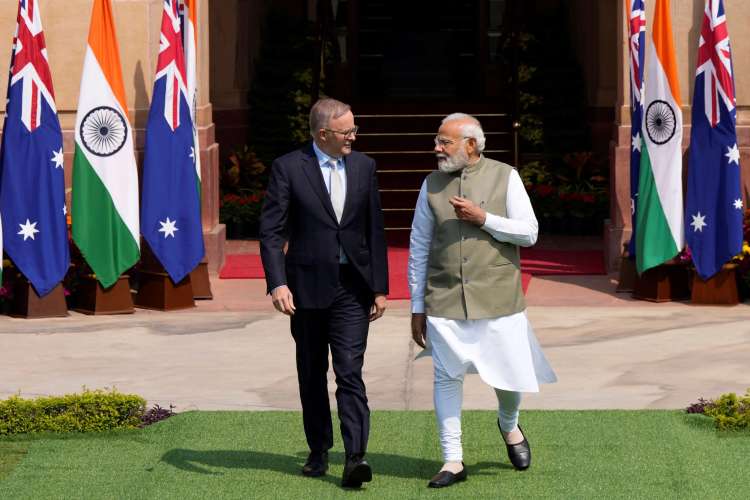
India-Australia defence deal: The strategic balance of the Indo-Pacific has undergone significant changes in recent years with the rise of China as a major power and its increasingly assertive presence in the region. The situation has prompted India and Australia, as well as other members of the QUAD group, to seek closer cooperation to ensure a stable and prosperous region. Although there is an agreement to cooperate on trade and co-production of defence equipment between the two countries, progress has been negligible.
This agreement, which is part of the defence and strategic partnership between Australia and India, was reaffirmed during the regular 2X2 meetings among the foreign and defence ministers of both countries. This cooperation has emerged as a crucial element in ensuring security, stability, and prosperity in the Indo-Pacific region. Similarly, the defence partnership between the US and India has been expanding swiftly and comprehensively, highlighting the Indo-Pacific as the raison d’être for this cooperation.
READ | Global semiconductor market: India makes a bold play for a toehold
The geography of the Indo-Pacific, home to two-thirds of the world’s population and accounting for around 60% of global trade and commerce, is abundant with natural and critical minerals and resources crucial for energy security. The Quad must also cooperate on critical minerals, many of which are exclusively available in China.
Significance of India-Australia deal
Australia and India, as maritime democracies and proponents of a free, open, prosperous, and inclusive Indo-Pacific, share common interests in safeguarding maritime security, ensuring freedom of navigation, and countering assertive behaviour in the region. With converging interests and complementary capabilities, the two countries have the potential to play a pivotal role in shaping the strategic landscape of the Indo-Pacific. Many policy experts have recently supported collaborative efforts and shared commitments in their analyses.
Peter Varghese, former Secretary of the Department of Foreign Affairs and Trade (DFAT) and now the chancellor of the University of Queensland, laid the foundation for a stronger Australia-India economic partnership through his report, “An India Economic Strategy to 2035, Navigating from Potential to Delivery.” Published by the Australian DFAT in 2018, the report initiated the drive for a relationship between India and Australia, crucial in the Indo-Pacific region.
One primary impediment highlighted by Varghese is the disparity in defence manufacturing capabilities between India and Australia. Despite significant modernisation of their militaries, bilateral relations are limited by India’s shift towards Make in India in the defence sector. “India is one of the world’s largest spenders on military equipment, and its procurement needs are met primarily through imports. But India’s shift towards indigenisation and Australia’s still nascent export-oriented defence manufacturing sector means export opportunities will be limited,” the report notes.
It underscores India’s endeavour to enhance its high-tech defence manufacturing capabilities and align them with Australia’s aspirations to diversify its defence exports. However, the path forward is fraught with complexities, including concerns over intellectual property rights and technology transfer agreements under India’s DefenceProcurement Policy. Varghese states, “Weak intellectual property laws will need to be addressed to enable joint ventures,” highlighting the potential for collaboration in niche manufacturing, research and development, and cybersecurity. In particular, Australia’s Defence Science and Technology Group seeks partnerships with India’s Defence Research and Development Organisation, focusing on non-sensitive technology areas to drive innovation and capability enhancement.
Australian defence manufacturers, especially SMEs, can leverage partnerships with Indian counterparts to tap into India’s burgeoning defence procurement market, thereby fulfilling offset obligations and fostering indigenous production capabilities. The maritime domain emerges as a focal point for collaboration, with prospects for joint ventures in maritime security and disaster relief operations. This sentiment was echoed at a discussion titled “Bolstering Australia-India Defence & Security Relations”, organised by CUTS International. One of the panellists, Commodore Anil Jai Singh, emphasised that “Even though Australia is 7000 miles away, it is still India’s most crucial neighbour to counter China in the Indian Ocean.”
Reflecting on past decades, Justin Bassi, Executive Director of the Australian Strategic Policy Institute, noted a shift in Australia’s perspective towards recognising the interconnectedness of economic and security issues. He traced the reformation of the Quad from 2017 onwards, emphasising its growing significance in addressing multiple challenges simultaneously. Bassi stressed “the need for the Quad to encompass both economic prosperity and security concerns, which are not two separate issues but one.”
Ambassador Anil Wadhwa, former senior Indian diplomat and Distinguished Fellow of CUTS, conducted a reciprocal study of India-Australia economic and trade dynamics in recent years for the Confederation of Indian Industry, titled ‘Australia Economic Strategy Report,’ released in 2020. The report highlights how “Australia’s capability investment will grow to $270 billion over the next decade, an increase from the $195 billion committed in the decade following the 2016 Defence White Paper.”
Wadhwa outlined five key areas for potential collaboration between India and Australia on defence issues, emphasising the significance of advanced technologies such as sensors, underwater technologies, quantum computing, lasers, and hypersonic technologies. These have tremendous potential for collaboration, particularly in shipbuilding, and need to be embedded in the cooperation framework. Secondly, the underwater domain awareness and protection of undersea assets, especially in strategic cable routes, represent an untapped domain for both nations.
Wadhwa stressed the importance of private sector cooperation in space technology for enhancing maritime domain awareness. He underscored the necessity for the Quad to deliver tangible outcomes, particularly in addressing regional challenges and fostering global good. Finally, the report discusses the limited defence equipment export opportunity from India to Australia, as Australia’s defence strategy hinges on indigenisation and increasing exports. This also enables India to participate in demands from Australia and global defence projects.
However, the road ahead is not without its hurdles. Concerns over the transfer of high-end defence technology, coupled with India’s push for full technology transfer as part of its ‘Make in India’ initiative, present challenges for deeper cooperation. While Australia remains a close security partner of India, the reluctance to transfer sensitive defence technologies underscores the need for a nuanced approach to collaboration. Navigating the Indo-Australian defence nexus, fostering trust, and addressing concerns surrounding intellectual property rights and technology transfer will be paramount.
Inspiration can be drawn from the Economic and Trade Agreement (ECTA), which is showing very positive results. Discussions are ongoing to graduate the ECTA to a Comprehensive Economic Cooperation Agreement (CECA), which could address some of the hurdles in the defence sectors also. Collaboration in non-sensitive technology areas, coupled with capacity-building initiatives and joint ventures, holds the key to unlocking the full potential of the bilateral relationship. As both nations embark on their journey towards modernisation and self-reliance, the imperative for closer defence cooperation has never been more apparent. By surmounting the challenges and seizing the opportunities outlined in both reports, India and Australia can pave the way for a stronger, more resilient partnership in the Indo-Pacific region and beyond.
(The authors work for CUTS International, a global public policy research and advocacy group.)
Pradeep S Mehta is the Secretary General of CUTS International, a leading policy research and advocacy group. He is a featured columnist with several leading publications in the country.

